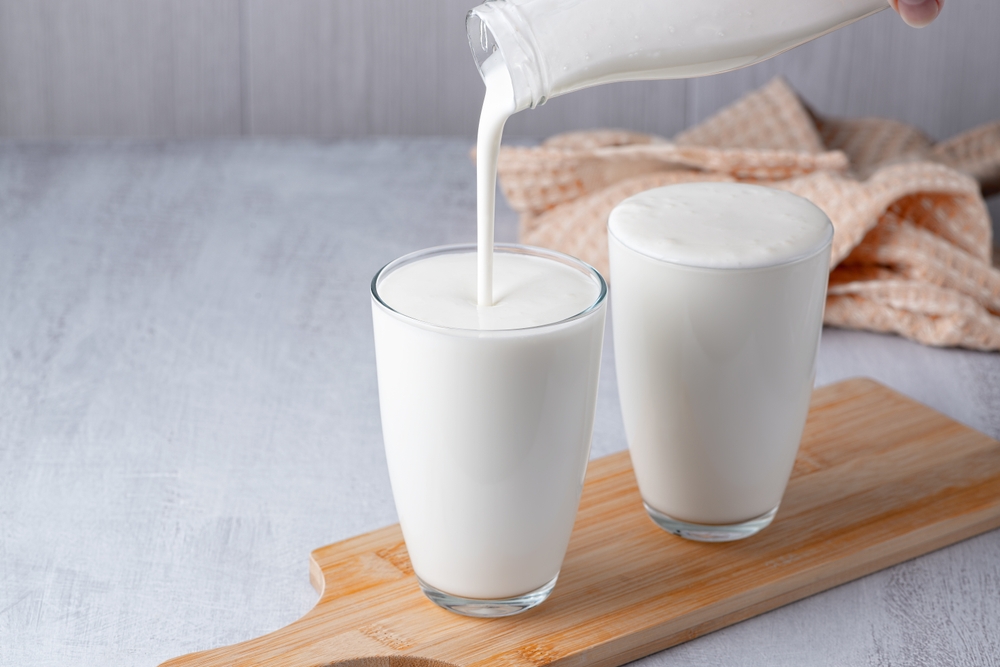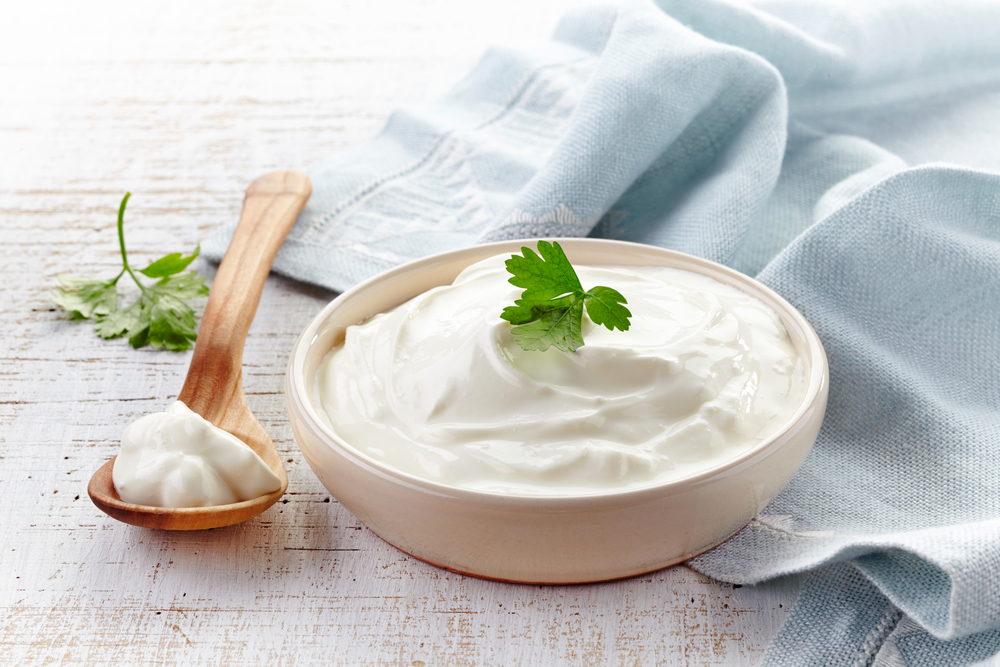As a home cook or baker, you may come across recipes that call for buttermilk or heavy cream. At first glance, you may think these two dairy products are interchangeable, but are they really the same?
In short, no. Buttermilk and heavy cream have different properties, and understanding these differences can help you achieve the desired outcome in your recipes.
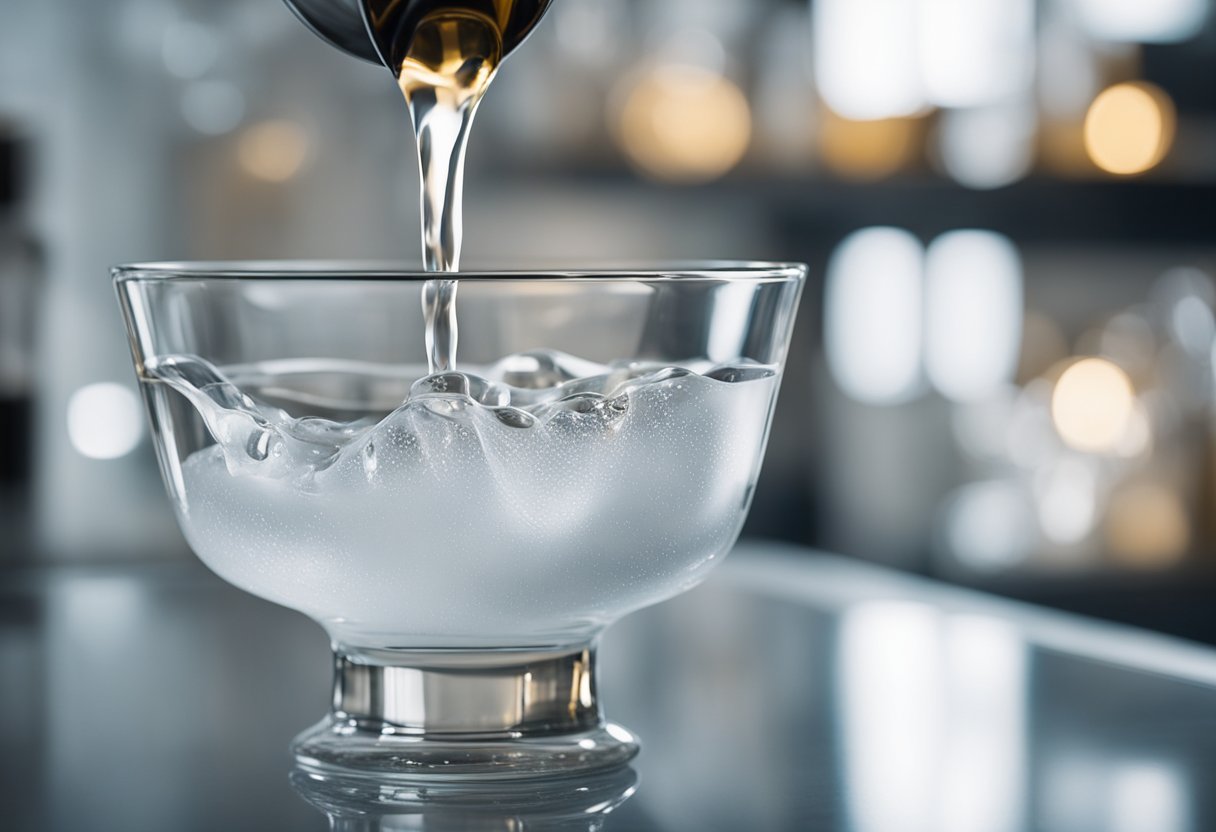
Buttermilk is a tangy, slightly acidic dairy product that is often used in baking, marinades, and dressings. It is made by adding a culture of lactic acid bacteria to milk, which causes the milk to ferment and thicken.
Heavy cream, on the other hand, is a rich and creamy dairy product that is often used in desserts and sauces. It is made by skimming the top layer of cream off of whole milk.
Heavy cream has a much higher fat content than buttermilk, which gives it a thicker and richer texture.
Understanding the differences between these two dairy products is important when it comes to cooking and baking, as substituting one for the other can significantly alter the taste and texture of your dish.
Key Takeaways
- Buttermilk and heavy cream are not the same dairy product and have different properties.
- Buttermilk is tangy and acidic, while heavy cream is rich and creamy.
- Understanding the differences between buttermilk and heavy cream is important when cooking and baking.
Understanding Buttermilk
As someone who loves to cook and bake, I know how important it is to understand the differences between ingredients. One common question that comes up is whether buttermilk is the same as heavy cream.
The short answer is no. Buttermilk and heavy cream are two different dairy products that have distinct properties and uses.
Buttermilk is a fermented dairy product that has a tangy flavor and sour taste. It is traditionally made by churning cream to make butter, and then mixing the leftover liquid with lactic acid bacteria.
The bacteria ferment the lactose in the milk, which produces lactic acid and gives the buttermilk its tangy flavor.
Buttermilk can also be made from low-fat milk that has been curdled with an acid, such as lemon juice or vinegar. This type of buttermilk is sometimes called “cultured buttermilk” and is widely available in grocery stores.
Compared to heavy cream, buttermilk has a much lower fat content and a thicker texture. It is often used in baking to add moisture and acidity to recipes, as well as to tenderize meat in marinades.
Buttermilk can also be used as a substitute for sour cream or yogurt in certain recipes.
In summary, buttermilk is a tangy, fermented dairy product that is lower in fat and thicker than heavy cream. It is commonly used in baking and cooking to add moisture and acidity to recipes, as well as to tenderize meat.
Understanding Heavy Cream
As someone who enjoys cooking and baking, I’ve often found myself wondering about the differences between buttermilk and heavy cream.
In this section, I’ll focus on heavy cream and provide some insights to help you understand what it is, how it differs from buttermilk, and when it’s best used.
Heavy cream is a dairy product that’s made by separating milk fat from milk. It’s also known as “whippable cream” or “heavy whipping cream” and has a rich, creamy texture that makes it a popular ingredient in many recipes.
Heavy cream typically contains around 36% milk fat, which is much higher than the fat content of regular milk. This high fat content is what gives heavy cream its thick, velvety texture and rich flavor.
One of the main differences between heavy cream and buttermilk is their fat content. While heavy cream has a high fat content, buttermilk has a much lower fat content, typically around 1%.
This means that heavy cream is much richer and creamier than buttermilk, and it’s also more versatile in the kitchen.
Heavy cream is great for adding richness and depth to sauces, soups, and desserts, while buttermilk is best used in recipes that require a tangy, acidic flavor.
Another important thing to note about heavy cream is that it’s whippable, which means it can be whipped into a thick, fluffy consistency.
This makes it a great ingredient for making whipped cream, which is a popular topping for desserts like pies, cakes, and ice cream.
Whipped cream can also be flavored with different ingredients like vanilla extract or cocoa powder to add extra depth and flavor.
Overall, heavy cream is a versatile and delicious ingredient that’s great for adding richness and depth to a wide variety of recipes.
Its high fat content, whippable texture, and rich flavor make it a popular choice for chefs and home cooks alike.
The Role of Buttermilk and Heavy Cream in Baking
As a baker, I know that buttermilk and heavy cream are two common ingredients in many recipes. However, they are not interchangeable, and each plays a unique role in baking.
Buttermilk
Buttermilk is a tangy, acidic ingredient that is commonly used in baking. It is made by adding bacteria culture to milk, which causes the milk to ferment and become acidic.
This acidity helps to activate baking soda, which is a leavening agent that helps baked goods rise. Buttermilk also adds a rich flavor and moist texture to baked goods.
Buttermilk is often used in recipes for biscuits, pancakes, and cakes. For example, buttermilk biscuits are a classic Southern dish that relies on the acidity of buttermilk to activate the baking powder and create a light, fluffy texture.
In cake recipes, buttermilk can be used to create a moist, tender crumb.
Heavy Cream
Heavy cream, on the other hand, is a rich, thick ingredient that is often used to add richness and creaminess to recipes.
It is made by skimming the cream off of milk and has a high fat content. Heavy cream is often used in recipes for sauces, soups, and desserts.
In baking, heavy cream can be used to add richness and flavor to recipes. It is often used in recipes for pies, where it can be used to create a creamy, custard-like filling.
Heavy cream can also be whipped to create whipped cream, which is a popular topping for cakes and other desserts.
When to Use Buttermilk vs. Heavy Cream
When it comes to baking, it is important to use the correct ingredient for the recipe. Buttermilk and heavy cream are not interchangeable, and using the wrong one can result in a baking disaster.
If a recipe calls for buttermilk, it is important to use buttermilk. Buttermilk is often used in recipes that require a leavening agent, such as baking soda or baking powder.
The acidity of buttermilk helps to activate the leavening agent, which is necessary for the recipe to rise properly.
If a recipe calls for heavy cream, it is important to use heavy cream. Heavy cream is often used in recipes that require richness and creaminess, such as sauces and desserts.
Using a substitute, such as milk or half-and-half, will not provide the same level of richness and creaminess as heavy cream.
In conclusion, buttermilk and heavy cream are two important ingredients in baking. While they may seem similar, they play unique roles in recipes. It is important to use the correct ingredient for the recipe to ensure the best results.
Taste and Texture Differences
When it comes to taste and texture, buttermilk and heavy cream couldn’t be more different. Buttermilk has a tangy taste and a thicker, lumpy texture, while heavy cream is sweetish and has a creamy, thin texture.
The sourness of buttermilk comes from the lactic acid bacteria that is added to low-fat milk during the fermentation process.
This gives it a tangy taste that can be quite overpowering if used in large amounts. Heavy cream, on the other hand, has a much milder flavor that is sweeter and richer due to its higher fat content.
In terms of texture, buttermilk is much denser and thicker than heavy cream. It has a lumpy texture that can be off-putting to some people, but it is perfect for adding a tangy flavor to baked goods and savory dishes.
Heavy cream, on the other hand, has a smooth and creamy texture that is perfect for making whipped cream or adding richness to soups and sauces.
It’s important to note that the fat content of buttermilk is only 1%, while heavy cream has an average fat content of 36%.
This makes it difficult to substitute one for the other in most recipes. However, in some cases, you can use a combination of milk and butter or milk and yogurt to mimic the texture and flavor of buttermilk.
Overall, when it comes to taste and texture, buttermilk and heavy cream are two very different ingredients that should not be used interchangeably.
While buttermilk adds a tangy flavor and dense texture to dishes, heavy cream adds richness and creaminess.
Nutritional Differences
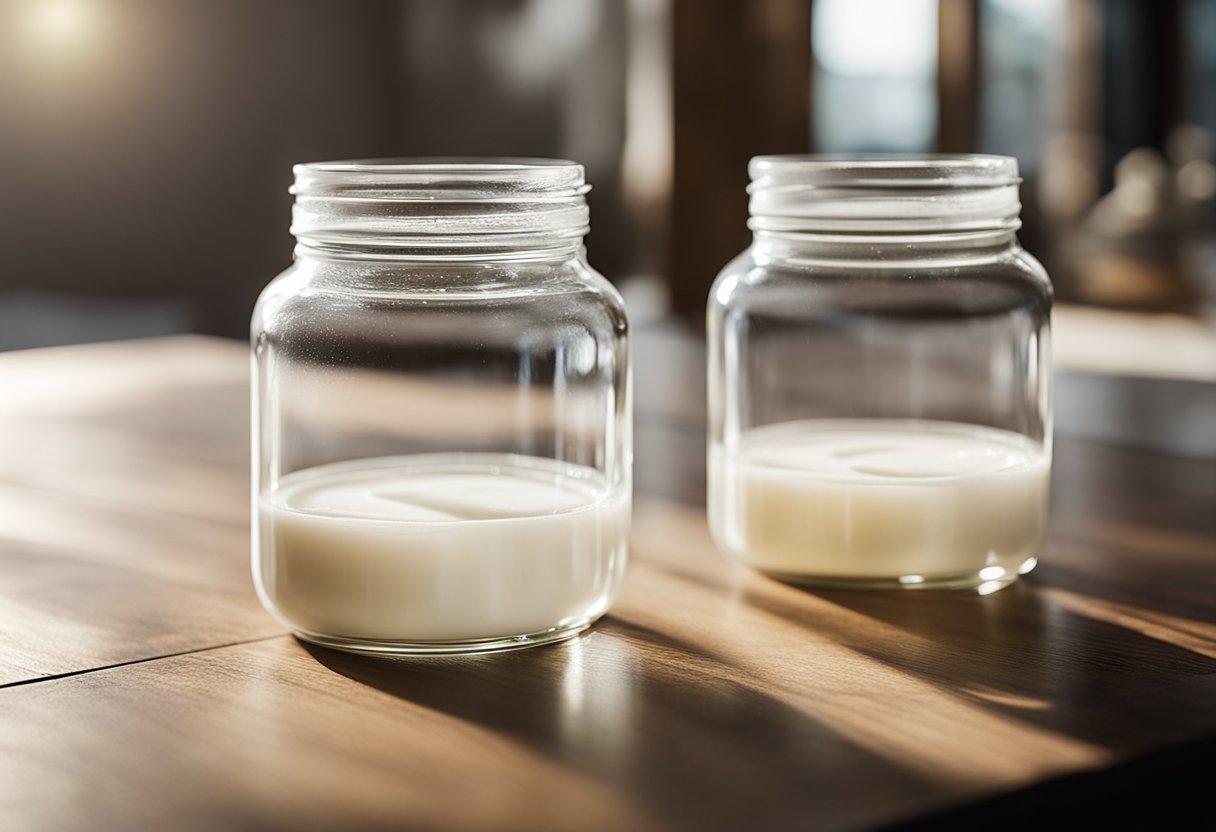
When it comes to nutritional differences, buttermilk and heavy cream are quite different from each other. Heavy cream has a much higher fat content, with an average of 36%, while buttermilk has only 1% fat.
This means that heavy cream is much higher in calories than buttermilk, with 100 grams of heavy cream containing around 340 calories, compared to only 40 calories in the same amount of buttermilk.
Buttermilk is also a good source of calcium, with around 100 milligrams of calcium per 100 grams of buttermilk. On the other hand, heavy cream contains only a small amount of calcium.
However, heavy cream is a better source of protein, with around 2 grams of protein per 100 grams of heavy cream, compared to only 0.9 grams of protein in the same amount of buttermilk.
If you are looking for a low-fat option, buttermilk is the clear winner. It is a great choice for those who are watching their calorie intake and trying to maintain a healthy weight.
Heavy cream, on the other hand, is a good option for those who need to increase their calorie and protein intake, such as athletes or bodybuilders.
In summary, while both buttermilk and heavy cream are made from milk, they have very different nutritional profiles.
Buttermilk is lower in calories and fat, but higher in calcium, while heavy cream is higher in calories and protein, but lower in calcium.
It is important to consider your nutritional needs when choosing between these two ingredients.
Substituting Buttermilk and Heavy Cream
When it comes to substituting buttermilk and heavy cream, it’s important to understand that they are not interchangeable in most recipes.
But there are some situations where you can use one in place of the other.
Substituting Buttermilk for Heavy Cream
If you’re looking to reduce the fat content in a recipe, you can substitute buttermilk for heavy cream.
But keep in mind that buttermilk has a tangy flavor and a thicker texture than heavy cream, so the end result will be different.
Here are some guidelines for substituting buttermilk for heavy cream:
- Use 1 cup of buttermilk for every 1 cup of heavy cream.
- Reduce the amount of liquid in the recipe by 1/4 cup for every 1 cup of buttermilk used.
- Add 1 tablespoon of cornstarch or flour to thicken the mixture, if needed.
Substituting Heavy Cream for Buttermilk
If you don’t have buttermilk on hand, you can use heavy cream as a substitute in some recipes. But keep in mind that heavy cream has a much higher fat content than buttermilk, so the end result will be richer and creamier.
Here are some guidelines for substituting heavy cream for buttermilk:
- Use 1 cup of heavy cream for every 1 cup of buttermilk.
- Add 1 tablespoon of vinegar or lemon juice to the heavy cream to mimic the tangy flavor of buttermilk.
- Let the mixture sit for 5-10 minutes to allow the acid to work its magic.
Other Substitutions
If you don’t have buttermilk or heavy cream, there are other ingredients you can use as a substitute. Here are some options:
- Yogurt: Use plain yogurt in place of buttermilk or heavy cream. It has a similar tangy flavor and texture.
- Sour Cream: Use sour cream in place of heavy cream. It has a similar richness and creaminess.
- Vinegar or Lemon Juice: Use vinegar or lemon juice to mimic the tangy flavor of buttermilk. Add 1 tablespoon of vinegar or lemon juice to 1 cup of milk and let it sit for 5-10 minutes.
- Homemade Butter: If you’re making your own butter, you can use the leftover liquid (known as buttermilk) in place of store-bought buttermilk.
Remember, when substituting ingredients, it’s important to keep in mind the flavor, texture, and fat content of the original ingredient.
With these guidelines, you can confidently substitute buttermilk and heavy cream in your recipes as needed.
Buttermilk and Heavy Cream in Cooking
When it comes to cooking, buttermilk and heavy cream are two dairy products that are often used in recipes. They both have their unique characteristics and uses, but they are not interchangeable.
Buttermilk
Buttermilk is a tangy and slightly sour liquid that is left over after churning butter. It has a low-fat content and is often used in baking recipes to add moisture and flavor.
Buttermilk is also used in marinades, dressings, and dips to add a tangy flavor.
In baking, buttermilk is often used to activate baking soda, which helps to leaven baked goods. It is also used in recipes for pancakes, waffles, and biscuits to make them tender and fluffy.
Buttermilk can also be used in soups and sauces to add a tangy flavor.
Heavy Cream
Heavy cream, on the other hand, is a rich and creamy liquid that is high in fat. It is often used in recipes to add richness and creaminess.
Heavy cream is used in recipes for sauces, soups, and desserts to add a smooth and velvety texture.
In baking, heavy cream is often used to make whipped cream, which is a common topping for cakes, pies, and other desserts. It can also be used to make ice cream, custards, and puddings.
Differences and Substitutions
While buttermilk and heavy cream are both dairy products, they cannot be substituted for each other in recipes.
Buttermilk has a tangy flavor and a low-fat content, while heavy cream is rich and creamy with a high-fat content.
When substituting one for the other, it is important to keep in mind the differences in flavor and texture. For example, substituting heavy cream for buttermilk in a recipe for pancakes will result in a much denser and richer pancake.
In conclusion, buttermilk and heavy cream are both important ingredients in cooking and baking. They have their unique characteristics and uses, and cannot be substituted for each other in recipes.
When using these dairy products in recipes, it is important to keep in mind their differences and to use them appropriately.
Buttermilk and Heavy Cream in Desserts
In desserts, both buttermilk and heavy cream can be used as ingredients, but they have different effects on the final product.
Buttermilk adds a tangy flavor to desserts and can be used to make cakes, muffins, and biscuits. It also helps to tenderize the batter and activate baking soda.
Buttermilk doesn’t whip like heavy cream, and it has a much lower fat content. This makes it a good choice for making lighter and fluffier desserts.
On the other hand, heavy cream is used to add richness and creaminess to desserts. It has a higher fat content than buttermilk, which gives it a more velvety texture.
Heavy cream is often used in frosting, ice cream, and other creamy desserts. It can be whipped to make whipped cream, which is a popular topping for desserts.
When it comes to substituting ingredients in desserts, it’s important to keep in mind the differences between buttermilk and heavy cream. In recipes that require a thick and creamy texture, heavy cream is the best choice.
But if you want to add a tangy flavor and make the dessert lighter, buttermilk is the way to go.
In some cases, you can substitute one for the other, but it’s important to consider the impact on the final product.
For example, if a recipe calls for whole milk, you can substitute it with a mixture of buttermilk and heavy cream to achieve a similar texture and flavor.
Overall, buttermilk and heavy cream are both versatile ingredients that can be used in a variety of desserts.
By understanding their differences and how they affect the final product, you can create delicious and unique desserts that your guests will love.
Making Homemade Buttermilk and Heavy Cream
I love using buttermilk and heavy cream in my cooking and baking, but sometimes it’s not readily available in my pantry. Luckily, it’s easy to make homemade versions of both using just a few simple ingredients.
Buttermilk
To make homemade buttermilk, all you need is some milk and an acidic ingredient like lemon juice or vinegar. I prefer using white vinegar because it has a neutral flavor that won’t affect the taste of my recipes.
Here’s how to make it:
- Measure out 1 cup of milk.
- Add 1 tablespoon of white vinegar.
- Stir the mixture and let it sit for 5-10 minutes until it thickens and curdles.
- Use it immediately or store it in the fridge for up to a week.
Homemade buttermilk won’t have the same tangy flavor as store-bought buttermilk, but it will still work well in recipes that call for it. Plus, it’s a great way to use up any extra milk you have in the fridge.
Heavy Cream
Making homemade heavy cream is a bit more involved than making buttermilk, but it’s still easy to do. You’ll need some unhomogenized milk and some cultures like yogurt or sour cream.
Here’s how to make it:
- Skim the cream off the top of 1 quart of unhomogenized milk.
- Add 1/4 cup of yogurt or sour cream to the cream.
- Stir the mixture and let it sit at room temperature for 12-24 hours until it thickens.
- Store it in the fridge for up to a week.
Homemade heavy cream will have a slightly different flavor and texture than store-bought heavy cream, but it will still work well in recipes that call for it.
Plus, it’s a great way to use up any extra milk you have and avoid having to make a trip to the store to buy a staple ingredient.
Differences Between Buttermilk and Heavy Cream
As a food enthusiast, I know that buttermilk and heavy cream are two dairy products that are commonly used in cooking and baking.
While they may look similar, they have distinct differences that affect their use in recipes.
One of the primary differences between buttermilk and heavy cream is their fat content. Heavy cream contains around 36% fat on average, while the fat content of buttermilk is only 1%.
This makes heavy cream a better choice for recipes that require a richer, creamier texture, such as whipped cream or ice cream.
On the other hand, buttermilk is ideal for recipes that require a tangy flavor and a lighter texture, such as scones or pancakes.
Another difference between buttermilk and heavy cream is their acidity level. Buttermilk has a higher acidity level than heavy cream, which makes it an excellent ingredient for baked goods.
The acidity in buttermilk helps to activate baking soda, which in turn helps baked goods to rise. Heavy cream, on the other hand, does not have the same acidity level, which makes it unsuitable for baking.
In terms of texture, buttermilk is thicker and lumpy, while heavy cream is quite thin. This difference in texture means that substituting one for the other is quite difficult and can work only in specific scenarios.
For example, if you need a substitute for heavy cream in a recipe, you can use a combination of milk and butter instead.
However, if you need a substitute for buttermilk, you can use a mixture of milk and vinegar or lemon juice.
To summarize, while buttermilk and heavy cream may look similar, they have distinct differences in terms of fat content, acidity level, and texture.
These differences make them suitable for different purposes in cooking and baking.
The Role of Buttermilk and Heavy Cream in Diet
As a nutritionist, I often get asked about the difference between buttermilk and heavy cream, and which one is better for a healthy diet.
Both buttermilk and heavy cream are dairy products, but they have different nutritional profiles and uses in cooking.
Buttermilk is a low-fat dairy product that contains only 1% fat. It is also rich in protein, calcium, and vitamin B12.
Buttermilk has a tangy flavor and a thick, creamy texture that makes it a popular ingredient in baking, marinades, and salad dressings.
It is also a good substitute for sour cream, yogurt, or cream cheese in recipes that call for a tangy flavor.
On the other hand, heavy cream is a high-fat dairy product that contains 36% fat on average. It is thicker and richer than buttermilk and has a slightly sweet flavor.
Heavy cream is commonly used in cooking and baking to add richness and creaminess to dishes like soups, sauces, and desserts.
However, due to its high fat content, heavy cream is not recommended for regular consumption as it can lead to weight gain and other health problems.
When it comes to diet, buttermilk is a better option than heavy cream as it is low in fat and calories. Buttermilk can be used as a substitute for heavy cream in recipes that require a creamy texture and tangy flavor.
For example, you can use buttermilk instead of heavy cream in mashed potatoes, soups, and sauces to reduce the fat content and add a tangy flavor.
In conclusion, buttermilk and heavy cream are two different dairy products that have different nutritional profiles and uses in cooking.
While buttermilk is a low-fat dairy product that is rich in protein and calcium, heavy cream is a high-fat dairy product that is used to add richness and creaminess to dishes.
When it comes to diet, buttermilk is a better option than heavy cream as it is low in fat and calories.
Frequently Asked Questions
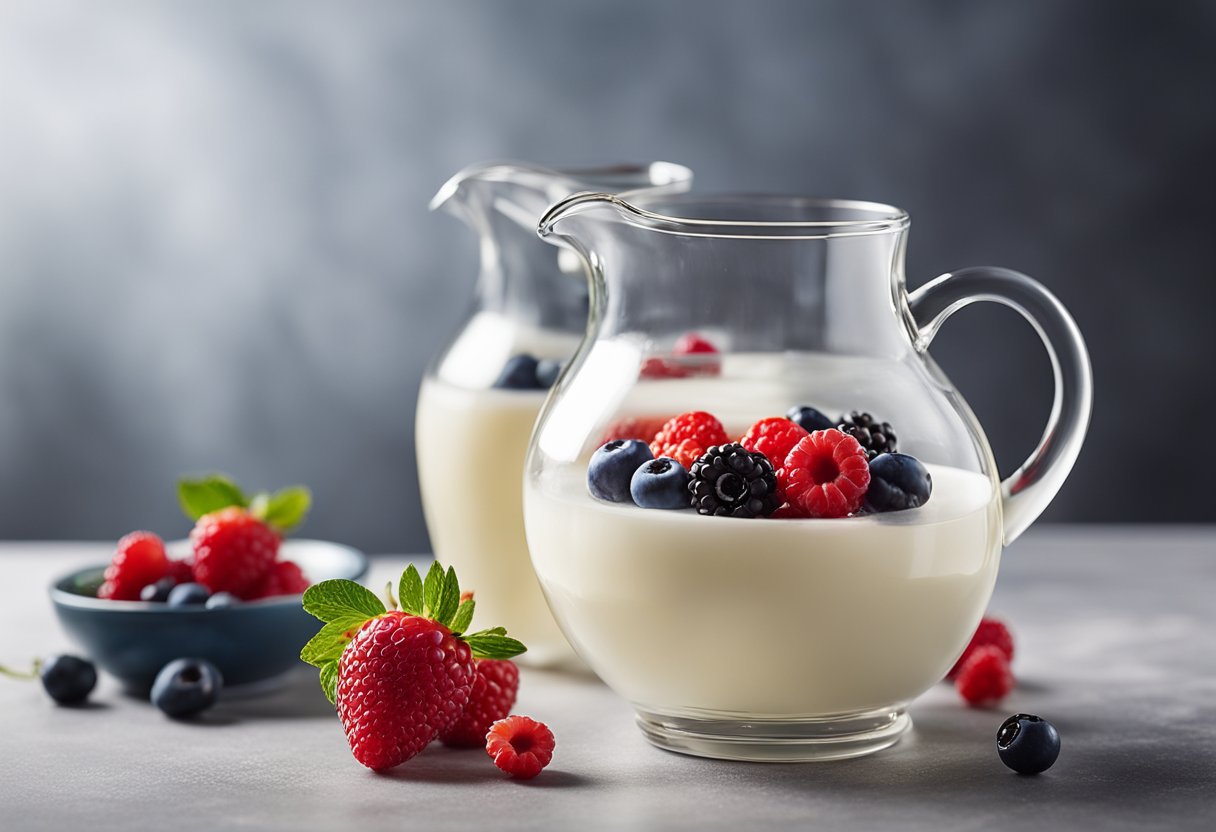
Can I use buttermilk instead of heavy cream in soup?
Buttermilk and heavy cream have different textures and fat contents, so they cannot be easily swapped in recipes. Heavy cream is thicker and has a higher fat content, while buttermilk is thinner and tangier.
If you use buttermilk instead of heavy cream in soup, it may affect the texture and flavor of the soup. However, you can try using a mixture of half-and-half and buttermilk as a substitute for heavy cream in soup.
Buttermilk vs heavy cream in cake: which is better?
Buttermilk and heavy cream have different effects on cakes. Buttermilk adds a tangy flavor and helps to tenderize the cake, while heavy cream adds richness and moisture to the cake.
The choice between buttermilk and heavy cream depends on the type of cake you want to make. If you want a light and tender cake, use buttermilk. If you want a rich and moist cake, use heavy cream.
How to make buttermilk from heavy cream?
To make buttermilk from heavy cream, you need to add an acidic ingredient such as lemon juice or vinegar to the cream. The acid will cause the cream to curdle and thicken, creating a buttermilk-like texture.
The ratio of heavy cream to acid is usually 1 cup of cream to 1 tablespoon of acid. Stir the mixture and let it sit for 5-10 minutes until it thickens.
What is the buttermilk to heavy cream ratio?
The ratio of buttermilk to heavy cream depends on the recipe you are making.
In general, buttermilk is thinner and tangier than heavy cream, so you may need to use more buttermilk than heavy cream in a recipe. A common ratio is 1 cup of heavy cream to 1/2 cup of buttermilk.
How to make buttermilk with heavy cream and vinegar?
To make buttermilk with heavy cream and vinegar, you need to mix 1 cup of heavy cream with 1 tablespoon of white vinegar.
Stir the mixture and let it sit for 5-10 minutes until it thickens and curdles. The resulting mixture will have a tangy flavor and a buttermilk-like texture.
Can I substitute buttermilk for heavy cream in Alfredo sauce?
Alfredo sauce is a rich and creamy sauce that is traditionally made with heavy cream. If you substitute buttermilk for heavy cream in Alfredo sauce, the sauce may be thinner and tangier than the original recipe.
However, you can try using a mixture of half-and-half and buttermilk as a substitute for heavy cream in Alfredo sauce.


